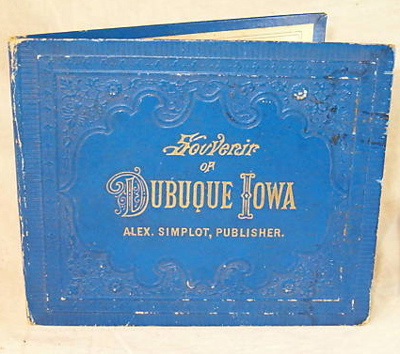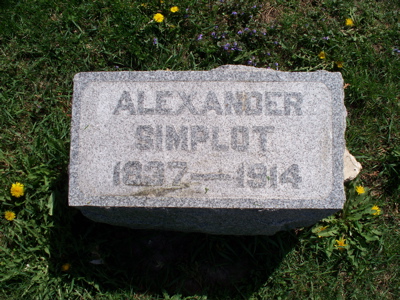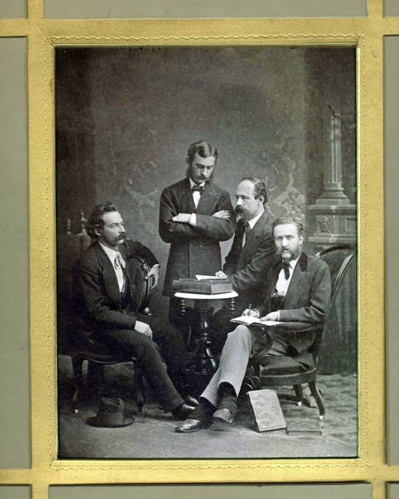Encyclopedia Dubuque
"Encyclopedia Dubuque is the online authority for all things Dubuque, written by the people who know the city best.”
Marshall Cohen—researcher and producer, CNN
Affiliated with the Local History Network of the State Historical Society of Iowa, and the Iowa Museum Association.
SIMPLOT, Alexander: Difference between revisions
No edit summary |
No edit summary |
||
| Line 1: | Line 1: | ||
[[Image:alexandersimplot.gif|left|thumb|250px|Alexander Simplot]]SIMPLOT, Alexander. (Dubuque, IA, Jan. 5, 1837--Dubuque, IA, 21, 1914). Simplot was born in a log cabin on Main street, between Fifth and Sixth [[STREETS]]. His parents, Henry and Susan Simplot, were among the earliest settlers of Dubuque County. His father was engaged in the general mercantile business and was one of the first Board of Alderman elected in Dubuque. He was one of the wealthiest men in Dubuque at the time of his death in 1847. | [[Image:alexandersimplot.gif|left|thumb|250px|Alexander Simplot and his wife Virginia Knapp]]SIMPLOT, Alexander. (Dubuque, IA, Jan. 5, 1837--Dubuque, IA, 21, 1914). Simplot was born in a log cabin on Main street, between Fifth and Sixth [[STREETS]]. His parents, Henry and Susan Simplot, were among the earliest settlers of Dubuque County. His father was engaged in the general mercantile business and was one of the first Board of Alderman elected in Dubuque. He was one of the wealthiest men in Dubuque at the time of his death in 1847. | ||
Young Alex went attended school conducted by the Dubuque Cathedral Parish. He then attended Rock River Seminary (equivalent to high school) at Mt. Morris, Illinois where classmates John A. Rawlings and later Illinois Governor Cullom also attended. Simplot had special privileges among the Union forces because Rawlins was General Ulysses S. Grant's chief aide. Alex entered Union College at Schenectady, New York, graduating from the Law Department in the class of 1858. He delivered a commencement address at his graduation entitled "Plea for Artists", however, his parents discouraged his desire to pursue an artistic career. | Young Alex went attended school conducted by the Dubuque Cathedral Parish. He then attended Rock River Seminary (equivalent to high school) at Mt. Morris, Illinois where classmates John A. Rawlings and later Illinois Governor Cullom also attended. Simplot had special privileges among the Union forces because Rawlins was General Ulysses S. Grant's chief aide. Alex entered Union College at Schenectady, New York, graduating from the Law Department in the class of 1858. He delivered a commencement address at his graduation entitled "Plea for Artists", however, his parents discouraged his desire to pursue an artistic career. | ||
| Line 11: | Line 11: | ||
Simplot returned to Dubuque after the Civil War in poor health. Secretary of the [[OLD SETTLERS' ASSOCIATION]] and the [[JULIEN DUBUQUE MONUMENT]] Association, Simplot has been credited with designing the Julien Dubuque Monument. He taught school for a few years and lost most of his inheritance in grain speculation. | Simplot returned to Dubuque after the Civil War in poor health. Secretary of the [[OLD SETTLERS' ASSOCIATION]] and the [[JULIEN DUBUQUE MONUMENT]] Association, Simplot has been credited with designing the Julien Dubuque Monument. He taught school for a few years and lost most of his inheritance in grain speculation. | ||
Many original pencil sketches came to the Wisconsin Historical Society in 1958 after being discovered in garage belonging to one of his grandsons in Madison. Journalist John Patrick Hunter tells how they were uncovered, and provides a short biography of Simplot, in his article, "Alexander Simplot, Forgotten Bohemian" (Wisconsin Magazine of History: Volume 41, number 4, summer, 1958: 256-261). The Society also owns a complete set of Harper's Weekly that contains the published engravings made from Simplot's sketches. | Many original pencil sketches came to the Wisconsin Historical Society in 1958 after being discovered in garage belonging to one of his grandsons in Madison. Journalist John Patrick Hunter tells how they were uncovered, and provides a short biography of Simplot, in his article, "Alexander Simplot, Forgotten Bohemian" (Wisconsin Magazine of History: Volume 41, number 4, summer, 1958: 256-261). The Society also owns a complete set of Harper's Weekly that contains the published engravings made from Simplot's sketches. | ||
[[Image:asimplot.jpg|right|thumb|250px|Gravestone in Linwood Cemetery]] | [[Image:asimplot.jpg|right|thumb|250px|Gravestone in Linwood Cemetery]] | ||
[[Image:simplotfriends.jpg|left|thumb|250px|Carl Guthers, Simplot, Bilbrough, and R. S. Merrill ca.1878. Photo courtesy: Merrillyn Shaw]] | [[Image:simplotfriends.jpg|left|thumb|250px|Carl Guthers, Simplot, Bilbrough, and R. S. Merrill ca.1878. Photo courtesy: Merrillyn Shaw]] | ||
Revision as of 03:44, 27 January 2012
SIMPLOT, Alexander. (Dubuque, IA, Jan. 5, 1837--Dubuque, IA, 21, 1914). Simplot was born in a log cabin on Main street, between Fifth and Sixth STREETS. His parents, Henry and Susan Simplot, were among the earliest settlers of Dubuque County. His father was engaged in the general mercantile business and was one of the first Board of Alderman elected in Dubuque. He was one of the wealthiest men in Dubuque at the time of his death in 1847.
Young Alex went attended school conducted by the Dubuque Cathedral Parish. He then attended Rock River Seminary (equivalent to high school) at Mt. Morris, Illinois where classmates John A. Rawlings and later Illinois Governor Cullom also attended. Simplot had special privileges among the Union forces because Rawlins was General Ulysses S. Grant's chief aide. Alex entered Union College at Schenectady, New York, graduating from the Law Department in the class of 1858. He delivered a commencement address at his graduation entitled "Plea for Artists", however, his parents discouraged his desire to pursue an artistic career.
Alexander returned to Dubuque and taught school. Simplot's drawing of volunteers boarding the steamer Alhambra at the harbor of Dubuque in April 1861, was the first sketch published by the magazine. The editors hired him to go to Cairo, Illinois and serve as a CIVIL WAR artist/correspondent. He was part of a group of correspondents that came to be known as "The Bohemian Brigade."
During his tenure with Harpers Weekly, which had 115,000 subscribers, Alexander documented the efforts of General Fremont, Commodore Foote, and General U.S. Grant. During his two years with the magazine, he produced fifty drawings and earned $1,250. At any given time the number of special artists covering the war numbered no more than twelve and during the four years of the war totaled only about thirty. Harpers still ranks him 13th among the 28 special artists to whom 10 or more published drawings can be credited. He headquartered at Cairo, Illinois, and covered the battles along the Mississippi. He was the only artist present to cover the Battle of Memphis, Tennessee. It was there that he made his most famous sketch showing Union gunboats blazing away at Confederate forces.
Simplot returned to Dubuque after the Civil War in poor health. Secretary of the OLD SETTLERS' ASSOCIATION and the JULIEN DUBUQUE MONUMENT Association, Simplot has been credited with designing the Julien Dubuque Monument. He taught school for a few years and lost most of his inheritance in grain speculation.
Many original pencil sketches came to the Wisconsin Historical Society in 1958 after being discovered in garage belonging to one of his grandsons in Madison. Journalist John Patrick Hunter tells how they were uncovered, and provides a short biography of Simplot, in his article, "Alexander Simplot, Forgotten Bohemian" (Wisconsin Magazine of History: Volume 41, number 4, summer, 1958: 256-261). The Society also owns a complete set of Harper's Weekly that contains the published engravings made from Simplot's sketches.
---
Source:
Alexander (Alex) Simplot. Online: www.findagrave.com/cgi-bin/fg.cgi?page=gr&GRid=16250513






